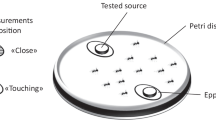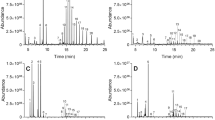Abstract
Ventral glands are common in nematine larvae (Hymenoptera: Symphyta), but they show various degrees of development and are functional for defense only in some species. In those species, volatile irritants are produced which are effective against ants. Alternative or complementary mechanisms against ants are the pubescence ofTrichiocampus spp., the foam pillars constructed byStauronema compressicornis, various movements of the abdomen, which occur independently of the glandular secretion in several species, immobility of the flat larvae ofNematinus luteus, and burrowing within plant tissues in gallicolous larvae or miners. Glandular development is not clearly related to the appearance of the larvae, either cryptic or aposematic. The secretion, even when it is produced in large amounts by species with well-developed glands, is only moderately efficient against great tits. Bright colors are found in gregarious larvae; these were accepted only with reluctance by great tits and sometimes rejected, even species in which the ventral glands are reduced. We suggest that the various volatile irritants secreted by ventral glands are aimed primarily against insects (e.g., ants) and only secondarily against birds.
Similar content being viewed by others
References
Alsop, D.W. 1970. Defensive glands of arthropods: Comparative morphology of selected types. PhD thesis, Cornell University, 378 pp.
Benson, R.B. 1950. An introduction to the natural history of British sawflies (Hymenoptera: Symphyta).Trans. Soc. Bri. Entomol. 10:45–142.
Benson, R.B. 1951 Handbooks for the Identification of British insects; Hymenoptera 2. Symphyta 6, Part 2(a), Royal Entomol. Soc., London, pp. 1–49.
Benson, R.B. 1952. 6, Part 2(b), pp. 51–137.
Benson, R.B. 1958. 6, Part 2(c), pp. 139–252.
Bergström, G.,Jonsson, S., andLanne, B.S. 1984. Volatile signals in the defence behavior of larch sawfly larvae (Pristiphora erichsonii andP. wesmaeli). XVII Int. Congress of Entomology, Hamburg Aug. 20–26. Abstract volume 448.
Boevé, J.L., Braekman, J.C., Daloze, D., Houart, M., andPasteels, J.M. 1984. Defensive secretions of Nematinae larvae (Symphyta Tenthredinidae),Experientia 40:546.
Coward, T.A. 1920–1926. The Birds of the British Isles, vols. 1–3. Frederick Warne, London.
Eisner, T. 1970. Chemical defense against predation in arthropods, pp. 157–217,in E. Sondheimer and J. B. Simeone (eds). Chemical Ecology. Academic Press, New York.
Eisner, T., Johnessee, J.S., Carrel, J., Hendry, L.B., andMeinwald, J. 1974. Defensive use by an insect of a plant resin.Science 184:966–999.
Fisher, R.A. 1930. The Genetical Theory of Natural Selection. Clarendon, Oxford.
Lorenz, H., andKraus, M. 1957. Die Larvalsystematik der Blattwespen (Tenthredinoidea und Megalodontoidea). Akademie Verlag, Berlin.
Maxwell, D.E. 1955. The comparative internal larval anatomy of sawflies (Hymenoptera: Symphyta).Can. Entomol. (Suppl. 1) 87:1–132.
Morrow, P.A., Bellas, T.E. andEisner, T. 1976. Eucalyptus oils in the defensive oral discharge of Australian sawfly larvae (Hymenoptera: Pergidae).Oecologia 24:193–206.
Nigitz, H.P. 1974. Über die Fichten-Nematinen (Hym., Tenthredinidae) der Steiermark.Z. Agnew. Entomol. 75:264–284.
Pasteels, J.M. 1976. Evolutionary aspects in chemical ecology and chemical communication, pp. 281–293. Proc. XVth Int. Cong. Entomol., Washington, D.C.
Pasteels, J.M., Grégoire, J.-C., andRowell-Rahier, M. 1983. The chemical ecology of defense in Arthropods.Annu.Rev. Entomol. 28:263–289.
Siegel, S. 1956. Nonparametric Statistics for the Behavioral Sciences. McGraw-Hill, New York.
Smith, E.L. 1970. Biosystematics and morphology of Symphyta. II. Biology of gall-making nematine sawflies in the California region.Ann. Entomol. Soc. Am. 63:36–51.
Tripp, H.A. 1962. The biology ofPerilampus hyalinus Say (Hymenoptera: Perilampidae), a primary parasite ofNeodiprion swainei Midd. (Hymenoptera: Diprionidae) in Quebec, with descriptions of the egg and larval stages.Can. Entomol. 94:1250–1270.
Williams, D.H., Santikarn, S., Oelrichs, P.B., De Angelis, F., Macleod, J.K., andSmith, R. J. 1982. The structure of a toxic octapeptide, containing 4-D-amino-acids, from the larvae of a sawfly,Lophyrotoma interrupta.J. Chem. Soc., Chem. Commun. 1012:1394–1396.
Yuasa, H. 1922. A classification of the larvae of the Tenthredinoidea.Ill. Biol. Monogr. 7:1–172.
Author information
Authors and Affiliations
Rights and permissions
About this article
Cite this article
Boevé, J.L., Pasteels, J.M. Modes of defense in nematine sawfly larvae. J Chem Ecol 11, 1019–1036 (1985). https://doi.org/10.1007/BF01020672
Received:
Accepted:
Issue Date:
DOI: https://doi.org/10.1007/BF01020672




